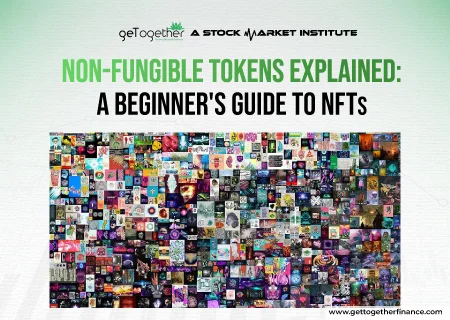Non-Fungible Tokens Explained: A Beginner’s Guide to NFTs


Table of Contents
ToggleOverview
Have you ever traded something digital, like a song or an image? You have noticed that it’s easy to share and copy these files, right? That’s because most digital assets are fungible, meaning they’re interchangeable – one copy is the same as another. But what if you wanted a digital item to be unique, like a rare trading card or a historical document?
Anuj Jasani famously quoted, “NFTs are digital real estate and it is going to be worth a lot more than real estate”. They are revolutionising the digital world by creating scarcity and verifiable ownership of digital items. With this blog, we will explore what are NFTs (non-fungible tokens), how it works, and what is its history. So without further ado, let’s begin.
What Are NFTs (Non-Fungible Tokens)

NFTs, or Non-Fungible Tokens, are rare digital assets that represent ownership or proof of authenticity of a specific item or piece of content, stored on a blockchain. Unlike cryptocurrencies like Bitcoin or Ethereum, which are fungible and can be exchanged one-to-one, each NFT is unique and cannot be exchanged on a one-to-one basis with another NFT. Here are the key aspects of NFT:
Uniqueness and Ownership
- Uniqueness: Each NFT has a unique identifier that makes it different from any other NFT. This uniqueness is what makes them “non-fungible.”
- Ownership: When you buy an NFT, you get proof that you own that specific digital item like artwork, music, videos, and even virtual real estate. This proof is stored securely on a blockchain, which is like a digital ledger that everyone can see but no one can change.
Digital Collectibles and Art
- Art: Artists can create digital artwork and sell it as NFTs. This lets them reach buyers directly and even earn money whenever the NFT is resold.
- Collectibles: NFTs are popular in the world of digital collectibles, such as virtual trading cards, in-game items, and other memorabilia.
Blockchain Technology
- Decentralization: NFTs are stored on a blockchain, which is a secure and decentralized network. The most common blockchain for NFTs is Ethereum, but other blockchains like Binance Smart Chain, Flow, and Polygon also support NFTs.
- Immutability: Once something is written on the blockchain, it can’t be changed. This means your ownership of an NFT is secure and verifiable.
How NFTs Work

Now after we decode what are NFTs, it’s important to understand how it really works. The process of making NFTs begins with the creation or minting of a digital item, such as art, music, videos, or even tweets, into an NFT. This minting process generates a unique, verifiable token that serves as a digital certificate of authenticity. Many blockchains offer a platform to create NFTs, however, often called with other names such as Ordinals for Bitcoin blockchain. Here is a simplified process of how it work:
- Creation: An artist creates a digital painting.
- Minting: The artist mints the painting as an NFT on the Ethereum blockchain, creating a unique token that represents the painting.
- Listing: The artist lists the NFT on an online marketplace for sale.
- Purchase: A buyer purchases the NFT, and the transaction is recorded on the blockchain, transferring ownership to the buyer.
- Ownership: The buyer now has proof of ownership of the digital painting, verifiable on the blockchain.
Examples of NFTs

They are digital non-fungible tokens that are rare and stored in blockchain technology, making users unable to temper its creation. Quantum (2014) by Kevin McCoy holds the title of the first-ever NFT. It’s a looping animation that was minted (recorded) on the Namecoin blockchain. Though initially sold for a mere $4, it was later re-sold for ₹1.08 crore ($1.47 million) in 2021.
Also Read: Fiat Currency v/s Cryptocurrency
Quantum (2014) by Kevin McCoy
Another example of popular NFT is Beeple’s “Everyday: The First 5000 Days”. This digital artwork is a collage of images created daily over 13 years, sold for $6900 crores at a Christie’s auction, showcasing the potential value of digital art NFTs.
Beeple’s “Everyday: The First 5000 Days” NFT
Another global NFT is Cryptopunk (2017), a pixelated avatar NFT that has fans globally, even in India. The cheapest CryptoPunks currently cost hundreds of thousands of dollars, translating to crores of rupees. However, the most expensive ones have sold for tens of crores.
Cryptopunk (2017)
“Consider” (2022) NFT by Indian artist Dhruv Kapoor is also one of the famous Indian NFTs that explores themes of mythology and technology. It sold for a respectable ₹22.5 lakh ($30,000) in the NFT market.
There are millions of NFTs that exist across various platforms, new ones minting every second. Few other well-known NFTs include IPL Cricket Collectibles, Madhushala NFTs (2021), CryptoArt by Pak, Kings of Leon’s Album “When You See Yourself”, Grimes’ Digital Art and Music, NBA Top Shot, Axie Infinity, Decentraland, The Sandbox, Somnium Space, Nyan Cat meme NFT, Jack Dorsey’s first tweet, Bored Ape Yacht Club NFT, and many more.
Benefits of NFTs

NFTs, or Non-Fungible Tokens, offer several unique benefits that make them appealing to creators, collectors, and investors. Here are some key advantages:
- Proof of Ownership and Authenticity: It provides verifiable proof of ownership and authenticity for digital assets. Each NFT is unique and recorded on a blockchain, ensuring that ownership can be easily verified and that the asset is genuine.
- Creator Royalties: NFTs often come with smart contracts that automatically pay royalties to creators whenever their NFTs are resold, ensuring creators benefit financially from their work beyond the initial sale.
- Global Reach: NFTs enable creators to reach a global audience without relying on intermediaries like galleries or auction houses.
- Digital Collectibles: They enable the creation and trading of unique digital items with potential value appreciation.
- Interoperability: It can be used across different platforms and virtual worlds. For example, a virtual item purchased as an NFT in one game might be used in other games or platforms that support the same standards, increasing its utility.
- Transparent Provenance: The blockchain records the entire history of an NFT, including its creation, ownership transfers, and transactions, maintaining its value, transparency, and authenticity.
- New Revenue Streams: It provide creators with new ways to monetize their work. From selling digital art and music to virtual real estate and gaming items, NFTs open up diverse revenue streams and financial opportunities.
- Secure Ownership: The blockchain’s security features ensure that NFT ownership is protected against tampering and fraud. Once an NFT is created and recorded, its ownership and details are secure and cannot be altered.
Limitations of NFTs – What Do Critics Say

Some critics claims that NFTs aren’t “real” because they are digital rather than physical assets. This lack of physical presence can make NFTs feel less legitimate or valuable compared to traditional assets like art, real estate, or collectables. The concept of what is “real” is subjective, and there is a growing tension between those who value physical assets and those who find authenticity. 1 in 3 Genz claimed to believe that they feel more authentic of themselves with their online identity and also share it as gifts for occasions.
On the flip side, They are claimed to be rare, and authentic, serving the creator, or the artists. However, critics believe that the file itself can still be easily copied and distributed online. So, while you own the NFT, you don’t necessarily own the underlying content in the strictest sense. This lack of exclusivity or control over the digital asset itself is a sticking point for some. They argue that true ownership implies control over duplication and distribution, which NFTs don’t inherently provide.
Despite this, there are several arguments over the alteration or replacement of NFT images due to the flawed technology behind it. Wall Street calls it a scam, a kind of turf war between the wealthy and the super-wealthy. Environmentalists resist the concept due to its high energy consumption leading to global warming. The concept is not generally accepted in the mindsets, however, the next generation is mostly closed to it due to their active behaviour toward digital worlds.
In A Nutshell
NFT are shaking up the digital world by changing how we think about ownership and creativity. What are NFTs can be simply defined as a modern world’s platform that gives artists and creators a new way to sell their work directly to fans, cutting out middlemen like galleries and record labels. However, while the excitement around NFTs is palpable, it’s super important to recognise that this market comes with its own set of challenges. On the flip side, the prices of NFTs can swing dramatically, making it a bit like a roller coaster ride for buyers and sellers. While the future of NFTs is still unclear, they are redefining what it means to own and appreciate art and content in the digital age.
FAQs
What Is the Concept Behind NFTs?
Non-Fungible Tokens use blockchain technology to create a digital certificate of ownership for an asset. This asset can be anything digital, like artwork, music, video game items, or even virtual land. The key feature is that each NFT is unique and cannot be replicated, similar to a one-of-a-kind trading card.
What is a smart contract?
A smart contract is a self-executing contract stored on a blockchain. It defines the terms of an agreement between two parties and automatically executes when those terms are met. In the context of NFT, smart contracts can be used to automate the sale and ownership transfer of NFTs.
What challenges/risks exist for the adoption of non-fungible tokens?
There are several challenges and risks related to NFTs such as volatility, environmental impact, technical limitations, etc.
How Does NFT Make Money?
NFTs make money through various means, primarily by allowing creators to sell their digital assets directly to buyers. When an NFT is sold, the creator receives payment in cryptocurrency, typically Ethereum. Investors and collectors can also profit by buying NFTs at a lower price and selling them at a higher price as the value of the digital asset appreciates.
What Is the Point of Having NFTs?
The point of having NFTs lies in their ability to provide verifiable ownership and authenticity for digital assets. NFTs allow artists, musicians, and other creators to monetize their work in the digital space, offering a new revenue stream. For collectors, NFTs represent unique, scarce digital items that can be owned, traded, and displayed.



 Facebook
Facebook Instagram
Instagram Youtube
Youtube
